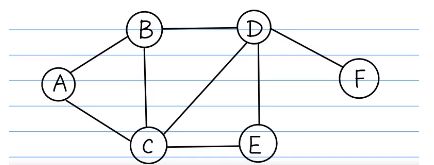python实现DFS和BFS整理
BFS是广度遍历,也就是一层一层扩展开的查找,先把第一层的找完,再找第二层,然后找第三层...使用到的数据结构是队列,先访问第一个节点,然后访问它的所有邻接点,然后访问邻接点的邻接点,在此过程中,要保证访问过的点不重复访问。
DFS是深度遍历,从一个点开始,逐渐沿着一条路径向下查找,查找到尽头的时候,回溯到上一个节点,再继续查找...使用的数据结构是栈,访问的下一个节点是当前节点的一个邻接点,然后访问其邻接点。
下面是一个图,我们使用python实现深度和广度遍历
graph = {
'A':['B','C'],
'B':['A','C','D'],
'C':['A','B','D','E'],
'D':['B','C','E','F'],
'E':['C','D'],
'F':['D']
}
def BFS(graph,s):
#使用队列存放每一层的元素
queue = []
seen = set()
queue.append(s)
seen.add(s)
# parent = {s : None}
while (len(queue) > 0):
#表示每次弹出的顶点
vertex = queue.pop(0)
nodes = graph[vertex]
for w in nodes:
if w not in seen:
queue.append(w)
seen.add(w)
print(vertex, end = " ")
BFS(graph,'A')
def DFS(graph,s):
#使用栈,下一个走的点是当前点的邻接点。
stack = []
seen = set()
queue.append(s)
seen.add(s)
# parent = {s : None}
while (len(queue) > 0):
#表示每次弹出的顶点
vertex = queue.pop(0)
nodes = graph[vertex]
for w in nodes:
if w not in seen:
queue.append(w)
seen.add(w)
print(vertex, end =" ")
BFS(graph,'A')
